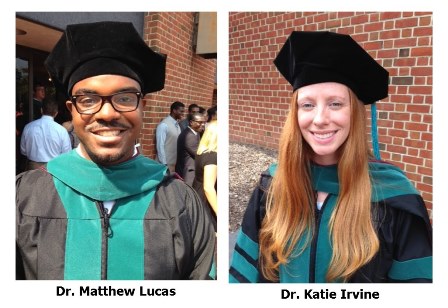
Thursday, December 1, 2016
PRINCESS ANNE, MD – (Dec. 1, 2016) – All 27 graduate students who earned doctorates in physical therapy this past September from the University of Maryland Eastern Shore passed the national licensure exam on the first try.
UMES’ class of 2016 is the third consecutive group of graduates to achieve that distinction, a string of success that marks a first for the university since it began awarding the Doctor of Physical Therapy degree 12 years ago.
“I’m proud of my classmates,” said Dr. Matthew G. Lucas, a newly minted physical therapist at Peninsula Regional Medical Center in Salisbury. “They’re all pretty smart. The school definitely prepared me for the test.”
To be licensed as a practicing physical therapist, Lucas and his classmates had to pass a standardized test administered on behalf of the Federation of State Boards of Physical Therapy.
Members of the class of 2016 acknowledged when receiving their degrees in September the “perfect” performances by their counterparts the two previous years was occasionally a topic of discussion.
“I really feel like it’s the instructors, the professors, the staff there and the class structure that helped us to get that passing rate,” said Dr. Katie Irvine, who works at Nanticoke Memorial Hospital in Seaford. “We were prepared.”
Dr. Rondall E. Allen, dean of UMES’ School of Pharmacy and Health Professions, said he was “extremely proud of the faculty and staff in the physical therapy department. They have been intentional and diligent in their efforts to prepare our students for the national exam.”
Allen and Interim Provost Kimberly Whitehead singled out for praise Dr. Michael Rabel, just the second department chairman since the university launched at the time an undergraduate program in 1981.
UMES is one of two Maryland universities with a physical therapy program, and among eight historically black institutions on the federation’s list of 226 accredited schools in the United States and Puerto Rico.
UMES typically receives hundreds of applications annually for roughly 30-to 34 spaces in a rigorous course of study that takes three years to complete.
The most recent group to graduate was UMES’ 12th to complete doctorate-level instruction, which includes extensive hands-on field work in clinical settings. Those experiences often lay the groundwork for job offers upon graduation, which was the case with Irvine, who grew up in Salisbury, and Lucas, originally from Mitchellville, Md. in Prince George’s County.
“The program gets you to where you need to be,” Lucas said. “A lot of people are there to support you and move you along in your career.”
The U.S. Bureau of Labor Statistics’ website says the average salary for a physical therapist in 2015 was $84,020
“Employment … is projected to grow at a much faster than the average for all occupations” over the next 8-to-10 years, the federal agency notes. “Physical therapists will be needed to treat people with mobility issues stemming from chronic conditions, such as diabetes or obesity.”
According to the Federation of State Boards of Physical Therapy, UMES is among 112 schools that can boast all of their graduates between 2012 and 2014 passed the national test, including those who took it more than once. UMES is the lone historically black institution in that select group.
Whitehead, the interim provost, said she “was excited to learn about the 100 percent pass rate on the National Physical Therapy Exam achieved by the UMES physical therapy class of 2016 on the first attempt.”
“This tremendous outcome,” she said, “speaks volumes about the high-quality, stellar educational experience offered by (our) physical therapy program.”
UMES Office of Public Relations, (410) 651-6669

